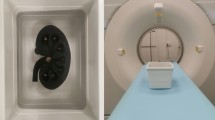Abstract
In this study, we aimed to investigate the feasibility of using Materialise’s interactive medical image control system (MIMICS) to measure urinary calculi volume. We used a cylinder measuring to measure the same polymer clay volume in different groups. Polymer clay was made into an oval shape, an antler type, and a multiple irregular shapes by hand. They are divided into three groups, that is, A, B, and C, each of which has seven polymer clays. The computer tomography (CT) 3D images of each sample were obtained by 256iCT scanning. The CT 3D image was imported into MIMICS to measure the theoretical volume and average CT value of polymer clay. The differences between the volume and CT values measured by MIMICS and 256iCT were evaluated. The volume of each polymer clay that was measured by a measuring cylinder was 34.7 ml. The average CT values of groups A, B, and C measured by 256iCT were 1121.3 ± 35.8, 1071.3 ± 22.2, and 1083.9 ± 6.3 Hu, respectively. The theoretical volume and CT values of the ceramics measured by MIMICS were as follows: the averaged volume of group A was 35.1 ± 0.4 ml, and the average CT value was 1065.7 ± 5.3 Hu. The average volume of group B was 34.5 ± 0.2 ml, and the average CT value was 1008.9 ± 7.7 Hu. The average volume of group C was 34.4 ± 0.5 ml, and the average CT value was 980.9 ± 6.1 Hu. MIMICS was reliable in measuring urinary stone volume. The difference between the CT values measured by MIMICS and 256iCT was statistically significant. MIMICS had a slightly lower CT value than that of 256iCT. However, from the data point of view, the difference between the two methods was small.

Similar content being viewed by others
References
Jepperson MA, Cernigliaro JG, Sella D et al (2013) Dual-energy CT for the evaluation of urinary calculi: image interpretation, pitfalls and stone mimics. Clin Radiol 68(12):707–714. https://doi.org/10.1016/j.crad.2013.07.012
Talso M, Emiliani E, Froio S et al (2019) Low-dose CT scan in stone detection for stone treatment follow-up: is there a relation between stone composition and radiation delivery? Study on a porcine-kidney model. Minerva Urol Nefrol 71(1):63–71. https://doi.org/10.23736/s0393-2249.18.03265-4
Sorokin I, Cardona-Grau DK, Rehfuss A et al (2016) Stone volume is best predictor of operative time required in retrograde intrarenal surgery for renal calculi: implications for surgical planning and quality improvement. Urolithiasis 44(6):545–550. https://doi.org/10.1007/s00240-016-0875-8
Zorba OÜ, Ogullar S, Yazar S et al (2016) CT-Based determination of ureteral stone volume: a predictor of spontaneous passage. J Endourol 30(1):32–36. https://doi.org/10.1089/end.2015.0481
Wilhelm K, Miernik A, Hein S et al (2018) Validating automated kidney stone volumetry in CT and mathematical correlation with estimated stone volume based on diameter. J Endourol 32(7):659–664. https://doi.org/10.1089/end.2018.0058
Ito H, Kawahara T, Terao H et al (2012) The most reliable preoperative assessment of renal stone burden as a predictor of stone-free status after flexible ureteroscopy with holmium laser lithotripsy: a single-center experience. Urology 80:524–528. https://doi.org/10.1016/j.urology.2012.04.001
Finch W, Johnston R, Shaida N et al (2014) Measuring stone volume-three-dimensional software reconstruction or an ellipsoid algebra formula? BJU Int 113(4):610–614. https://doi.org/10.1111/bju.12456
Jain R, Omar M, Chaparala H et al (2018) How accurate are we in estimating true stone volume? A comparison of water displacement, ellipsoid formula, and a CT-based software tool. J Endourol 32(6):572–576. https://doi.org/10.1089/end.2017.0937
Erdogan H, Temizoz O, Koplay M et al (2019) In vivo analysis of urinary stones with dual-energy computed tomography. J Comput Assist Tomogr 43(2):214–219. https://doi.org/10.1097/rct.0000000000000831
Stępień M, Chrzan R, Gawlas W (2018) In vitro analysis of urinary stone composition in dual-energy computed tomography. Pol J Radiol 83:e421–e425. https://doi.org/10.5114/pjr.2018.79588
Atalay HA, Ülker V, Alkan İ et al (2016) Impact of three-dimensional printed pelvicaliceal system models on residents’ understanding of pelvicaliceal system anatomy before percutaneous nephrolithotripsy surgery: a pilot study. J Endourol 30(10):1132–1137. https://doi.org/10.1089/end.2016.0307
Pan S, Su JJ, Syed J et al (2019) Reduced dose computed tomography: the effects of voltage reduction on density measurements of urolithiasis. J Endourol. https://doi.org/10.1089/end.2019.0149
Author information
Authors and Affiliations
Corresponding author
Ethics declarations
Conflict of interest
We declared that we do not have any commerical or associative interest that reprents a conflict of inerest in connection with the work.
Additional information
Publisher's Note
Springer Nature remains neutral with regard to jurisdictional claims in published maps and institutional affiliations.
Rights and permissions
About this article
Cite this article
Wang, J., Huang, Z., Wang, F. et al. Materialise’s interactive medical image control system (MIMICS) is feasible for volumetric measurement of urinary calculus. Urolithiasis 48, 443–446 (2020). https://doi.org/10.1007/s00240-019-01158-6
Received:
Accepted:
Published:
Issue Date:
DOI: https://doi.org/10.1007/s00240-019-01158-6




